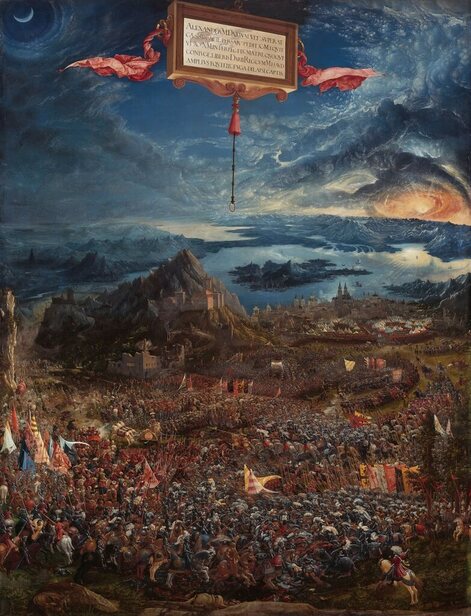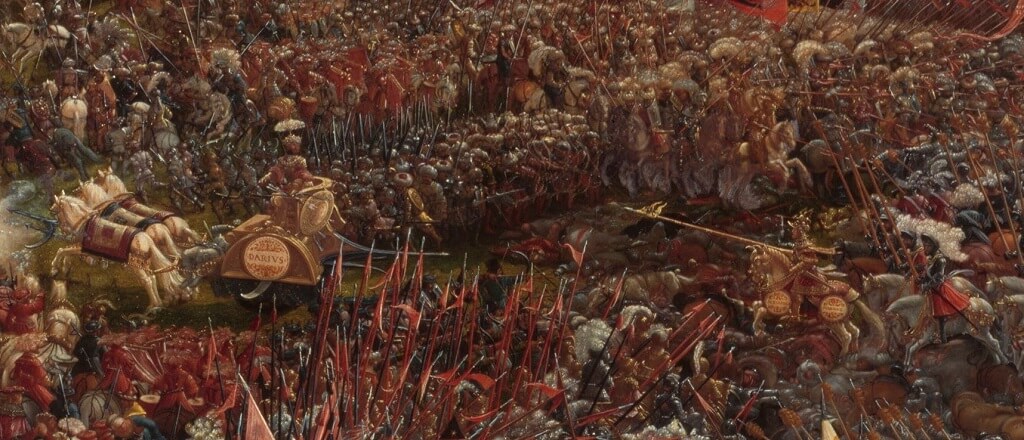|
Where? Room I of the Alte Pinakothek in Munich
When? 1529 Medium and size: Oil on panel, 158.4 cm × 120.3 cm. Commission: Duke William IV of Bavaria commissioned a series of historical paintings from various artists for his summer house at the Royal Study. They included both biblical and other historical paintings. What do you see? It shows the cosmic battle at Issus in 333 BC. Altdorfer captured the end of the battle between the Persian King Darius III and Alexander the Great. The painting contains thousands of warriors on the battlefield. In the left foreground, the army with the red and black lances is the Persian one of Darius III. They go head to head with the Hellenic squadron, in the right foreground, fighting for Alexander the Great. Just above this battle is the main scene with, on the left, Darius III on his chariot carried by three off-white horses. He is fleeing the battlefield, realizing that they have lost the battle. To his right, leading the Macedonian army with his outstretched lance is Alexander the Great chasing Darius III. Above the scene with Darius and Alexander, more battles occur with the Macedonians on the right and the Persians on the left. The banners for each army contain information on the supposed number of soldiers killed and taken hostage.
Background of the painting: Altdorfer created a large and dramatic sky, including both the sun (on the right) and the moon (on the left). The moon symbolizes Eastern culture, and the sun represents Western culture.
The landscape is not a realistic depiction of the area around Issus but more a symbolic one of the whole Eastern-Mediterranean area. A little to the left and below the sun, one can recognize the Nile delta with its seven arms. And below that, in the middle of the basin, is the island of Cyprus (above the city of Issus with its church towers). Above this island is the Red Sea. And on the left side, just before the mountains, one may see the contours of a city, probably representing Constantinople. Inscription: The banner on top of the painting contains the following inscription: "ALEXANDER M.DARIUM VLT: SVPERAT / CAESIS IN ACIE PERSAR; PEDIT: CM.EQVIT / VLRO XM.INTERFECTIS. MATRE QVOQVE / CONIVGE, LIBERIS DARII REG: CVM M. HAVD / AMPLIVS EQVITIB: FVGA DILAPSI, CAPTIS" It can be translated as follows: Alexander the Great defeating the last Darius; after 100,000 infantry and more than 10,000 Persian horsemen were killed amongst the ranks of the Persians. While King Darius could flee with no more than 1,000 horsemen, his mother, wife, and children were taken prisoner."
Backstory: The painting is part of the history cycle that Duke Wilhelm IV of Bavaria and his wife Jacobaea of Baden commissioned in 1528 for their Munich Residence. It represents the war between the West and the East, with the West winning this time. It relates to the East vs. West sentiments in 1529, when this work was painted, when the Ottoman army was nearing the gates of Vienna (and the Ottoman Sultan Suleiman the Magnificent would be defeated at the siege of Vienna). When looking at the battle in some detail, it appears more like a Medieval battle than one from ancient times. This is also known as an anachronism, where Altdorfer placed an ancient battle in a modern environment. The Persians, for example, look more like 16th-century Ottomans, and the Macedonians are wearing 16th-century steel armor.
The panel was initially a bit larger, but over time the panel was cut down for unknown reasons on all sides and mostly on the top. Who is Alexander the Great? Alexander the Great (356 BC–323 BC) was the king of the ancient Greek kingdom of Macedon. He succeeded his father at age 20 in the year 336 BC. Alexander the Great spent the first ten years expanding his territory dramatically, and by age 30, his empire stretched from Greece to India. He is considered one of the most successful military commanders in history. Who is Darius III? Darius III (c. 380 BC–330 BC) was the last Achaemenid King of Persia, reigning from 336 to 330 BC. During his short reign, he had to deal with the invasion of Alexander the Great, who would beat the Persian armies several times, and finally destroyed their capital Persepolis. The Battle at Issus: Took place on November 5, 333 BC, at Issus, a settlement located near the Mediterranean coast in the South of Turkey, near the border with Syria. The sizes of each army are heavily debated, but the general thought is that Darius' army consisted of about 100,000 troops, outnumbering the 40,000 troops in the army of Alexander the Great. The army of Alexander the Great won the battle, and they chased the Persian army until nightfall. After that, they returned to the battlefield to bury the dead and to take care of the camp of Darius III, where his family was stuck. The battle would be a turning point in history, leading to the dominance of Hellenistic culture for centuries to come. Who is Altdorfer? Albrecht Altdorfer (1482–1538) was a German painter, engraver, and master builder. He was born around 1482/1485, probably in Regensburg. His artistic career is somewhat obscure. In 1505, he acquired citizenship in Regensburg. Around 1512, he started to work for Emperor Maximilian l. He held a number of public offices in Regensburg. In 1528 the city granted him "exemption from business" for the Duke of Bavaria, probably because he was working on the major commission for The Battle of Alexander at Issus. Fun fact: The painting initially stayed for almost three centuries with the Dukes of Bavaria, who had it regularly exhibited in the 18th century. But in 1800, the army of Napoleon took the painting to Paris. Napoleon was a great admirer of Alexander the Great. Initially, the painting ended up in the Louvre, but Napoleon took it to one of his residences in 1804. When the Prussians captured his castle in 1814, they reportedly found the painting in Napoleon's bathroom.
Written by Eelco Kappe
References:
0 Comments
Leave a Reply. |
Categories
All
|
- Home
- Blog
-
Museums
- Alte Pinakothek
- Art Institute of Chicago
- Baltimore Museum of Art
- Barber Institute of Fine Arts
- Bargello
- Barnes Foundation
- British Museum
- Church of Sant’Anastasia
- Cleveland Museum of Art
- Courtauld Institute of Art
- Detroit Institute of Arts
- Frans Hals Museum
- Galleria Borghese
- Gallerie dell'Accademia
- Getty Museum
- Guggenheim
- Hermitage Museum
- Kunsthistorisches Museum
- Kunstmuseum Basel
- Legion of Honor Museum
- Louvre
- Mauritshuis
- Metropolitan Museum of Art
- Musee d’Orsay
- Museum of Fine Arts in Boston
- Museum of Modern Art
- National Gallery in London
- National Gallery of Art
- National Museum in Poznań
- Norton Simon Museum
- Ny Carlsberg Glyptotek
- Palace of Versailles
- Palazzo Pitti
- Palazzo Vecchio
- Petit Palais
- Philadelphia Museum of Art
- Prado
- Pushkin Museum
- Ravenna Art Museum
- Rijksmuseum
- San Diego Museum of Art
- Santa Maria delle Grazie
- St. Peter's Basilica
- Städel Museum
- Statens Museum for Kunst
- Tate Britain
- Tate Modern
- Timken Museum of Art
- Uffizi
- Vatican Museums
- Wallace Collection
-
Artists
- Altdorfer
- Anguissola
- Berlin Painter
- Bosch
- Botticelli
- Boucher
- Bronzino
- Bruegel the Elder
- Brunelleschi
- Cabanel
- Caillebotte
- Canova
- Caravaggio
- Carpeaux
- Cezanne
- Cimabue
- David
- Degas
- Delacroix
- De Maria
- Donatello
- El Greco
- Fontana
- Fra Angelico
- Fragonard
- Gauguin
- Gentileschi
- Gericault
- Gonzalez-Torres
- Goya
- Hals
- Hogarth
- Hokusai
- Ingres
- Leonardo da Vinci
- Lippi, Filippo
- Longhi, Barbara
- Lorrain
- Makovsky
- Manet
- Massys
- Matisse
- Merian
- Michelangelo
- Mochi
- Modigliani
- Monet
- Panini
- Parmigianino
- Perugino
- Picasso
- Pisanello
- Raphael
- Rembrandt
- Renoir
- Reynolds
- Rivera
- Rodin
- Rubens
- Scultori
- Seurat
- Steen
- Tintoretto
- Titian
- Toulouse-Lautrec
- Turner
- Uccello
- Van der Weyden
- Van Dyck
- Van Eyck
- Van Gogh
- Van Hemessen
- Vasari
- Velazquez
- Vermeer
- Veronese
- Vigée Le Brun
-
Locations
- Books
- About Us



